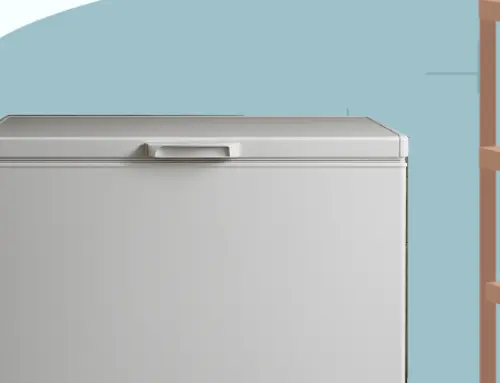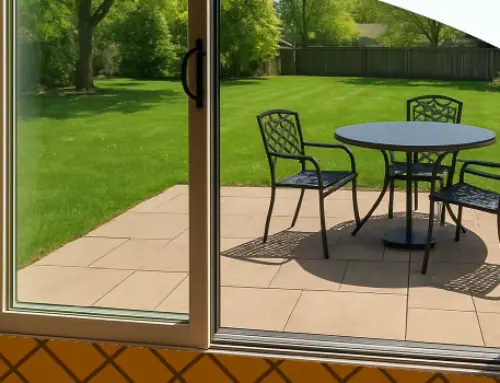What Size Tankless Water Heater Do I Need If I Live in PA?
by Tyler Castle
14.4 min read
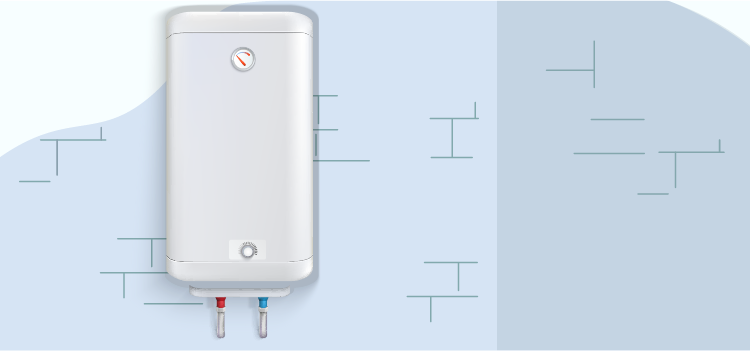
Choosing the right size tankless water heater is crucial for ensuring a consistent supply of hot water while maximizing energy efficiency. Unlike traditional water heaters, which store gallons of hot water, tankless models heat water on demand, making them an ideal choice for eco-conscious homeowners. Did you know the size water heater you choose can make all the difference?
While it's challenging to decipher which size heater is ideal for your home, we're here to walk you through it. We'll go through what factors you need to consider when choosing a heater, how sizing works, and how to find the exact size you'll need. Let's hop in!
Why size matters in tankless water heaters
Finding the right size tankless water heater impacts your home's overall comfort and efficiency. If your tank is too small for your home, it may not supply enough hot water during peak usage times, leading to cold showers and frustration. On the other hand, if your unit is too large, it can lead to added energy costs.
Typical tankless water heater types
When selecting a tankless water heater, it's important to understand the different types available and how they match your household needs:
Electric Tankless Water Heaters: These units are compact and typically have lower flow rates compared to gas-powered models. They are ideal for smaller homes or apartments where hot water demand is moderate.
Propane Tankless Water Heaters: Propane models are more powerful and can handle higher flow rates than electric heaters, making them suitable for larger homes or those with higher hot water needs.
Natural Gas: Natural gas tankless water heaters provide high flow rates but require a natural gas connection.
Point of Use Heaters: These are small, compact units designed to be installed close to specific fixtures, such as sinks or showers.
How tankless water heater sizing works
Two primary factors that need to be considered when determining the right size water heater for your application:
The maximum flow rate required by the hot water system, which is measured in gallons per minute (GPM). Maximum flow is determined by the number of fixtures that will be used at the same time, and the flow rate of each of those fixtures.
And your groundwater temperature depending on your location, the water temperature will cool and heat at different rates in your tankless water heater. Knowing your location's groundwater temperature helps ensure that the water heater you choose can effectively meet your hot water needs throughout the year.
Key factors to consider when sizing your tankless water heater
Flow Rate (GPM)
Flow rate refers to the volume of water that passes through your pipes per minute. This metric is crucial because it helps you understand how much hot water your system can deliver at any given time.
To calculate the flow rate, you'll need to determine the amount of fixtures – like showers and faucets – that can be used at the same time. You'll also need to determine the flow rate of each fixture. Here are the typical flow rates for common fixtures in your home:
Flow Rate in Gallons Per Minute of Common Fixtures in Your Home
| Fixture | Flow Rate |
|---|---|
| Faucets | 2.5 |
| Toilet | 2.2 |
| Shower | 2.5 |
| Dishwasher | 2.0 |
| Washing Machine | 4.0 |
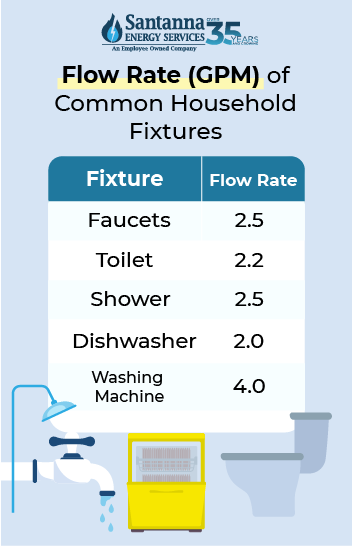
Once you’ve determined the flow rate for all the fixtures in your home, add together every flow rate (also measured in gallons per minute) for all your fixtures that could be used at the same time. This total will give you the maximum flow rate your tankless water heater needs to accommodate.
Temperature Rise
Temperature rise refers to the difference between the groundwater temperature that enters your pipes and the desired temperature you’re looking to heat your water to. Groundwater temperatures vary based on your location. Here’s a map that depicts the average groundwater temperature across the U.S.:
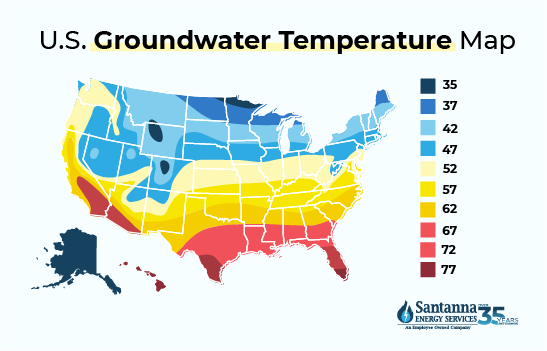
To calculate your required temperature rise, simply subtract the groundwater temperature from your location minus your desired output temperature. Although some manufacturers set water heater thermostats at 140ºF, most households usually only require tankless water heaters to be set at 120ºF
For example, taking the most common groundwater temperature from the following states, and the recommended output temperature according to the Department of Energy, residents in Pennsylvania, Ohio, Illinois, and Michigan can anticipate a temperature rise of:
Estimated Temperature Rise for a Tankless Hot Water Heater
| State | Average Ground Water Temperature | Desired Output Temperature | Estimated Temperature Rise |
|---|---|---|---|
| Pennsylvania | 47 | 120 | 73 |
| Ohio | 52 | 120 | 68 |
| Illinois | 52 | 120 | 68 |
| Michigan | 42 | 120 | 78 |
Amount of people in your household
The last factor to take into account when sizing your tankless water heater is the number of people in your home. The more people in your household means there’s more water demand. With more water demand, this might mean you’ll have to invest in more tankless water heaters to meet demand.
Example of how to size a tankless water heater at home with calculations
Now that we’ve covered how the calculations work, let’s show you an example of how the calculations come together to determine your overall size. Here’s how to size your tankless hot water heater if you live in Pennsylvania:
Step-by-step flow rate calculation
Let’s say hypothetically, you’re living in Lancaster, Pennsylvania and you’re part of a family of four. The water appliances in your home include:
- A dishwasher at 2.0 GMP
- Two toilets at 2.5 GMP each
- A washing machine at 4.0 GMP
- Two shower fixtures at 2.5 GMP each
- And six faucets at 2.5 GMP each
Adding together all the flow rates of your fixtures would equal 31 GPM, the maximum flow rate your tankless water heater needs to accommodate your Pennsylvanian home and family of four.
Step-by-step temperature rise calculation
To calculate the temperature rise to size your tankless water heater, determine your groundwater temperature. In this scenario, if you’re living in Lancaster, Pennsylvania, your groundwater temperature would be 52 degrees Fahrenheit.
Next, decide what temperature you want your water heater to produce. 120°F is the ideal tankless water heater temperature.
So, taking 120°F (desired output) – 52°F (groundwater) = 72°F, is the ideal temperature rise for a tankless water heater for someone living in Lancaster, PA.
Combining both factors to figure out your ideal tankless water heater size
How can you use both these calculations to determine the right size? Look at tankless water heater models and check their maximum GPM and the temperature rise you calculated. You can find the flow rate and temperature rise within the product description when you’re surfing the web looking for a model.
Odds are you won’t be using all your fixtures at the same time regularly but you want to make sure your tank is big enough to handle guests and high hot water demand.
In general, a 10 GPM tankless water heater is ideal for most common households. If your household has high hot water demands, consider installing multiple units to share the load.
Regional considerations for homeowners
If you think you’re ready for a tankless water heater, consider these regional factors before you purchase:
Groundwater Temperatures: These temperatures and your location play a major part in the size of your tankless water heater. If you purchase a unit that doesn’t have a temperature rise that matches your local groundwater conditions, it may struggle to deliver the desired hot water temperature efficiently.
Regional Hot Water Demand: Household sizes and water usage patterns also affect the size of the tankless water heater you need. In regions with colder climates, households typically use more hot water during winter months due to increased heating needs and less frequent outdoor activities. This can drive up hot water demand where a larger or more powerful tankless water heater might be needed.
Impact of Climate: In colder climates, water heaters may need to work harder to maintain efficiency and provide consistent hot water. Choosing a high-efficiency model with good insulation and advanced technology can help manage energy costs and ensure reliable performance despite the demanding conditions.
What size tankless water heater is suitable for your household?
If you’re wondering what size tankless water heater is right for your household, consider this breakdown by Navien:
- 3.5 GPM for 1-2 fixtures simultaneously
- 5 GPM for 2-3 fixtures simultaneously
- 7 GPM for 3-4 fixtures simultaneously
The size of the water heater you choose will obviously depend on your household size and your hot water demand. Using these estimates, here’s a hypothetical breakdown of what size tankless water heater you’ll need for a family of five or less if you’re in the Midwest region:
Recommended Tankless Water Heater Sizes for Pennsylvania Residents
| Household Size | Typical Hot Water Usage | Average Groundwater Temperature | Number of Fixtures in Use Simultaneously | Recommended Tankless Water Heater Size (GPM) |
|---|---|---|---|---|
| 2 People | Low to Moderate | 47 | 1-2 Fixtures | 3.5 GPM |
| 3 People | Moderate | 47 | 2-3 Fixtures | 5 GPM |
| 4 People | Moderate to High | 47 | 3-4 Fixtures | 7 GPM |
| 5 People | High | 47 | 4+ Fixtures | 7+ GPM |
Recommended Tankless Water Heater Sizes for Ohio Residents
| Household Size | Typical Hot Water Usage | Average Groundwater Temperature | Number of Fixtures in Use Simultaneously | Recommended Tankless Water Heater Size (GPM) |
|---|---|---|---|---|
| 2 People | Low to Moderate | 52 | 1-2 Fixtures | 3.5 GPM |
| 3 People | Moderate | 52 | 2-3 Fixtures | 5 GPM |
| 4 People | Moderate to High | 52 | 3-4 Fixtures | 7 GPM |
| 5 People | High | 52 | 4+ Fixtures | 7+ GPM |
Recommended Tankless Water Heater Sizes for Illinois Residents
| Household Size | Typical Hot Water Usage | Average Groundwater Temperature | Number of Fixtures in Use Simultaneously | Recommended Tankless Water Heater Size (GPM) |
|---|---|---|---|---|
| 2 People | Low to Moderate | 52 | 1-2 Fixtures | 3.5 GPM |
| 3 People | Moderate | 52 | 2-3 Fixtures | 5 GPM |
| 4 People | Moderate to High | 52 | 3-4 Fixtures | 7 GPM |
| 5 People | High | 52 | 4+ Fixtures | 7+ GPM |
Recommended Tankless Water Heater Sizes for Michigan Residents
| Household Size | Typical Hot Water Usage | Average Groundwater Temperature | Number of Fixtures in Use Simultaneously | Recommended Tankless Water Heater Size (GPM) |
|---|---|---|---|---|
| 2 People | Low to Moderate | 42 | 1-2 Fixtures | 3.5 GPM |
| 3 People | Moderate | 42 | 2-3 Fixtures | 5 GPM |
| 4 People | Moderate to High | 42 | 3-4 Fixtures | 7 GPM |
| 5 People | High | 42 | 4+ Fixtures | 7+ GPM |
Do I need more than one tankless water heater?
When considering a tankless water heater, one of the most common questions homeowners ask is whether a single unit will be sufficient to meet their household’s hot water demands. The answer largely depends on your home’s size, the number of residents, and the simultaneous usage of multiple water fixtures.
Some advantages of installing multiple tankless water heaters are:
- Can ensure that every part of your home has a consistent and reliable hot water supply, even during peak usage times.
- Each heater can be dedicated to specific areas or tasks, reducing the strain on a single system.
- Multiple smaller units can be easier to install in tight spaces compared to one large unit.
- If one unit requires maintenance or repairs, having additional heaters ensures that your home won’t be entirely without hot water.
When assessing if you need more than one unit consider how many people live in your home and how often multiple hot water fixtures are used simultaneously. If your household frequently uses several showers, faucets, and appliances at the same time, a single tankless water heater may struggle to keep up.
Large or multi-story homes may benefit from multiple units to avoid long waits for hot water to reach distant fixtures. Lastly, in colder regions where hot water is needed to stay comfortable, hot water is used more often which increases demand.
Best tankless water heaters
If you’re on the search for the best tankless water heater for your home, let us help. Here are some of the best tankless water heaters for your home:
- Rheem 18kW 240VV: This unit has a flow rate of up to 4.4 GPM with durable immersion of two heating elements. This appliance is ideal for mid-range whole-home appliances and with Rheem’s self-modulating technology can save Up to 50 percent on your water heating bill.
- Eco-smart ECO 11: This affordable model guarantees consistent on-demand hot water and is 90% smaller than traditional hot water tanks. As a bonus, this model is highly efficient, using 99% thermal energy with automatic temperature adjustment.
- Stiebel Eltron Tempera 24 Plus: Ideal for larger homes, this hot water unit Advanced Flow Control patented technology. This means that when your unit is running out of hot water capacity, it automatically lowers your shower flow to ensure consistent hot water.
- Rinnai RE140iN Non-Condensing Natural Gas Tankless Water Heater: Offering a clear LED screen to set schedules and reminders, your heater can be paired with WiFi for energy monitoring and system updates.
Tankless water heater maintenance
Once you’ve found the right model for your home, don’t forget to regularly maintain your system. Here are a couple of frequent maintenance tips to look out for:
- Regular Descaling: Scale often collects in your tankless water heater which affects your unit’s overall performance. Scale can clog heating elements which will cause your heat exchangers to use more energy than it has to. Have your heater descaled 3 years after your first installation and again, 5 years after that as long as no sediment is found.
- Check and Clean the Air Filter: Over time, these filters can become clogged, which can reduce the unit’s efficiency. Use a rag and a small brush to clean out debris in your filter.
- Flush the System: Flushing the entire system is a crucial maintenance step, especially if you live in an area with hard water. Flushing the system helps remove any sediment that could lead to costly repairs.
- Check for Leaks: Regularly inspect your tankless water heater for any signs of leaks around the connections, valves, and pipes. Even small leaks can lead to water damage, reduce the efficiency of the unit, and increase your energy bills.
- Inspect the Venting System: In the case of gas-powered tankless water heaters, ventilation is essential. Regularly inspect the venting system to ensure there are no blockages, damage, or signs of corrosion. Failing to check your ventilation can lead to carbon monoxide build-up.
FAQ’s
How do I flush a tankless water heater?
Flushing your tankless water heater is crucial to maintaining a well-running machine. Here’s how to flush your tankless water heater in a few simple steps:
- Start by turning off the power to your tankless water heater and closing the water supply valves. There should be a blue inlet valve for the cold water and a red outlet valve for the hot water.
- Connect the hoses to the inlet and outlet valves and use pliers to ensure the values are tight.
- Attach the end of the inlet hose to a circulation pump and place it in a bucket with one gallon of water and a few cups of vinegar or cleaning solution. Attach the inlet hose to the discharge side of the pump.
- Open your valves and let water flow through your pump; circulate this water for at least an hour.
- Turn off the circulation pump, then turn off both valves and disconnect the inlet hose. To flush out the remaining cleaning agent, keep the hose connected to the hot water outlet valve and turn on the cold water inlet valve. Continue this for 10 minutes then reconnect your system.
The exact process will vary based on your model.
How does a tankless water heater work?
A tankless water heater works by heating water on demand rather than storing it in a tank. Cold water flows through the unit, where it’s quickly heated by either gas burners or electric elements. The heated water is then delivered directly to your tap, providing an endless supply of hot water without the need for a storage tank.
How to install a tankless water heater.
Here’s how to install a tankless water heater:
- Shut off the water, gas (if applicable), and electricity to the area where you’ll be installing the unit.
- Securely mount the tankless water heater on the wall, ensuring it’s level and has enough clearance for ventilation if you’re using a natural gas heater.
- Attach the cold water supply and hot water outlet pipes to the unit.
- If your unit is gas-powered, connect the gas line to the heater. If it’s electric, wire it according to the manufacturer’s instructions.
- If you’re using a gas unit, install the venting system to safely exhaust gases outside the home.
- Turn the water, gas, and electricity back on. Check for leaks, and run the system to ensure it’s heating water properly.
- Your exact installation process will vary based on model, size, and if you’re using multiple units. Try to avoid installing your tankless water heater on your own and ask for professional help. A DIY installation could lead to injury or system malfunction.
How to reset tankless water heater.
This is generally how you can reset a tankless water heater:
- Find the reset button on your tankless water heater. It’s usually located on the front panel or near the control board.
- Press and hold the reset button for a few seconds.
- After resetting, check the display for any error codes. If an error persists, refer to the user manual for troubleshooting steps.
Your exact reset process will vary based on your model.
There’s peace of mind in knowing you’ll pay the same monthly supply cost amount for your electricity or natural gas supply without any uncertainty — no matter what. Santanna’s Unlimited Energy option protects your bills from fluctuating supply charges no matter the changes in seasons. For over 35 years, Santanna has served customers in Illinois, Indiana, Pennsylvania, Michigan, and Ohio. Our mission is to provide innovative and cost-effective energy solutions that will help our customers achieve their energy goals.
Tyler is an experienced energy professional, having worked for Santanna Energy Services, for the past four years. He is passionate about renewable energy and believes that diversifying the energy grid is the key to a sustainable future. Tyler is dedicated to supplying consumers with the best possible energy solutions and works diligently to make sure that Santanna can deliver the highest quality service.



